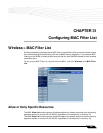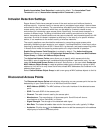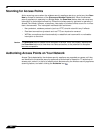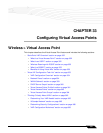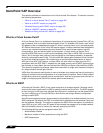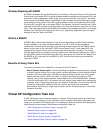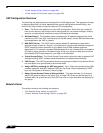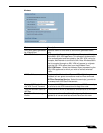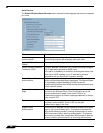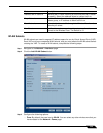
Wireless > Virtual Access Point
353
SonicOS Enhanced 4.0 Administrator Guide
Wireless Roaming with ESSID
An ESSID (Extended Service Set IDentifier) is a collection of Access Points (or Virtual Access
Points) sharing the same SSID. A typical wireless network comprises more than one AP for the
purpose of covering geographic areas larger than can be serviced by a single AP. As clients
move through the wireless network, the strength of their wireless connection decreases as they
move away from one Access Point (AP1) and increases as they move toward another (AP2).
Providing AP1 and AP2 are on the same ESSID (for example, ‘sonicwall’) and that the (V)APs
share the same SSID and security configurations, the client will be able to roam from one to the
other. This roaming process is controlled by the wireless client hardware and driver, so roaming
behavior can differ from one client to the next, but it is generally dependent upon the signal
strength of each AP within an ESSID.
What Is a BSSID?
A BSSID (Basic Service Set IDentifier) is the wireless equivalent of a MAC (Media Access
Control) address, or a unique hardware address of an AP or VAP for the purposes of
identification. Continuing the example of the roaming wireless client from the ESSID section
above, as the client on the ‘sonicwall’ ESSID moves away from AP1 and toward AP2, the
strength of the signal from the former will decrease while the latter increases. The client’s
wireless card and driver constantly monitors these levels, differentiating between the (V)APs
by their BSSID. When the card/driver’s criteria for roaming are met, the client will detach from
the BSSID of AP1 and attach to the BSSID or AP2, all the while remaining connected the
‘sonicwall’ ESSID.
Benefits of Using Virtual APs
This section includes a list of benefits in using the Virtual AP feature:
• Radio Channel Conservation—Prevents building overlapped infrastructures by allowing
a single Physical Access Point to be used for multiple purposes to avoid channel collision
problem. Channel conservation. Multiple providers are becoming the norm within public
spaces such as airports. Within an airport, it might be necessary to support an FAA
network, one or more airline networks, and perhaps one or more Wireless ISPs. However,
in the US and Europe, 802.11b networks can only support three usable (non-overlapping)
channels, and in France and Japan only one channel is available. Once the channels are
utilized by existing APs, additional APs will interfere with each other and reduce
performance. By allowing a single network to be used for multiple purposes, Virtual APs
conserve channels.
Virtual AP Configuration Task List
A VAP deployment requires several steps to configure. The following section provides first a
brief overview of the steps involved, and then a more in-depth examination of the parts that
make up a successful VAP deployment. This subsequent sections describe VAP deployment
requirements and provides an administrator configuration task list:
• “VAP Configuration Overview” section on page 354
• “Network Zones” section on page 354
• “WLAN Subnets” section on page 359
• “DHCP Server Scope” section on page 360
• “Virtual Access Points Profiles” section on page 361



